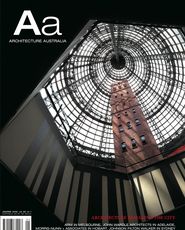GILLING AND THE OPERA HOUSE
Don Bailey’s obituary for Ron Gilling needs correction with regard to the controversy surrounding Utzon and the Sydney Opera House. Ron Gilling was a good president and one of the best chairpersons I have known, and I can believe Bailey when he says that the Utzon affair was for Gilling “a bitter and obsessive disappointment” for the rest of his life. But the facts are not quite as lilywhite as Bailey records.
I was a councillor of the NSW Chapter when Utzon resigned in 1966 and at the next council meeting demanded to know what the Institute intended to do to support Utzon. Ron Gilling, as President, said he had been taken to lunch by Davis Hughes, the Minister for Public Works, who had sworn him to secrecy and then told him in great detail what a mess Utzon was making of everything. Gilling thought that the RAIA should do nothing but, sworn to secrecy, couldn’t say why! In his opinion the Institute should take no action – Utzon had resigned, there was nothing we could do. The younger members of the council, Milo Dunphy, Phil Jackson and I, refused to accept this position.
Making confidential allegations to discredit someone is an old political trick to neutralize potential opponents and Gilling was not the first person to have fallen for it. Supported by Dunphy and Jackson, I moved a motion of “No confidence in the Council” and forced an Extraordinary General Meeting of members, which was held in the Lower Town Hall.
The hall was filled to overflowing; I hadn’t realized till then how many architects there were in Sydney.
Milo Dunphy and I spoke in support of the motion; I can’t remember whether anyone spoke against it. The vote was recorded by counting raised hands, with a dozen people counting in different parts of the hall, an imperfect method in a crowded hall, and the motion narrowly failed to get up. It galvanized all sorts of actions outside the Institute in support of Utzon, all ineffective, unfortunately, as he had already made the mistake of resigning.
At the next council meeting Ron Gilling played back what had been said at the Town Hall, deplored our speeches and suggested that Milo should resign because of the things he had said. It was Milo’s background, I think, with a grandfather who was a Presbyterian Minister, that caused him never to moderate his language – things were always black and white with Milo. I said if Milo resigned I would too, and in the end it all fizzled out. Our actions caused a lot of bitterness and resentment on the conservative Chapter Council at the time which came home to roost later, but that’s another story… ›› Now, Ron Gilling may have done his best in all sorts of ways later; he may have tried to get Utzon reinstated as Bailey suggests, but at the crucial time Ron Gilling was prepared to sit back and do nothing.
He always took our opposition as in some way personal criticism, which it wasn’t. I liked him as a person and he was always helpful when I was first elected onto the council. In my opinion he had simply been outwitted by a clever politician into taking a stand which he probably regretted later. I will be interested to read Gilling’s version of events that he deposited in the State Library.
There were many problems with the whole Opera House process, but Utzon had been engaged as architect for the building, it was under construction and he should have had the support and help of his professional body. Most of the profession thought so, and Utzon himself certainly always thought he had been let down by the Institute.
DON GAZZARD
AWARDS NIGHT
I was delighted to attend the 2005 National Architecture Awards at the Sydney Opera House on October 27.
Although I don’t work in the profession, I was excited to be in the presence of Australia’s experienced and emerging architects. I felt privileged to have seen so many wonderful designs throughout the night.
For the following weeks I read the coverage in various magazines and watched programmes on TV about the awards and the winning designs.
During the night, winners mentioned that many of the designs were labours of love that took ten, fifteen or in some cases twenty years to complete! I believe the words heart and soul were even mentioned as winners articulated the depth of their involvement in completing the work. In all the comments made by the winners, the support and relationship with the client was the constant theme.
Although I agree that a good relationship with the client is critical, a trend emerged throughout the speeches. Not one of the award recipients on the night thanked their families for their support. With some projects taking years to complete, how many late nights, working weekends, missed dinners or just-not-being-there occasions did these winners and their families go through?
Architects of Australia, at the next awards night I attend I hope not only to hear how supportive and great the clients were, but how much you appreciated the love, patience and support of your families. Living with such passionate, artistic professionals for twenty, forty, sixty or more years is our labour of love – and I should know, as I married one!
MANUELA SCHMID
FIXES
• Simon Hardy, general manager of Lend Lease design, writes to point out that The Bond was incorrectly attributed to PTW and Lend Lease in Radar Headlines in September/October (Architecture Australia vol 94, no 5). The credit should have read Lend Lease design in collaboration with PTW.
• Alex Tzannes tells us that Philip Rossington was the design architect for the Arthur House, by Alexander Tzannes Associates, which was awarded a Commendation for Residential Architecture in last year’s RAIA National Awards (Architecture Australia vol 94, no 6).















